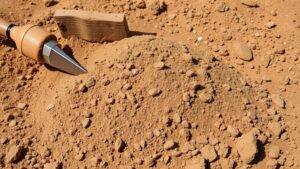The Use of Ore Sorting Huts for Early Concentration in Agricola’s Methods
Introduction
The use of ore sorting huts for early concentration in Agricolas methods represents a crucial development in the historical practices of mineral prospecting and mining. Had Agricola not documented techniques for the efficient separation of valuable minerals from ore, the mining industry might have evolved far differently. These huts served as makeshift laboratories, optimizing the extraction process long before modern technology was available. Throughout history, the fundamental principles of ore sorting have evolved from basic hand-picking to sophisticated mechanical processes, reflecting the advancement of mining practices across different eras.
Foundational Concepts and Equipment
To understand the core functionalities of ore sorting huts, it is essential to define key terms and review the pertinent equipment used in early mining practices. Ore sorting refers to the process of separating valuable minerals from waste materials, ensuring that only the most economically viable ore is processed further.
Some of the essential tools and materials include:
- Sorting Tables: Flat surfaces where miners would visually inspect and hand-sort minerals based on size and color.
- Pans and Buckets: Used to transport materials to the sorting area and to separate heavier valuable minerals through gravity methods.
- Crushing Hammers: Tools used to break down larger ore chunks into manageable sizes for better sorting efficiency.
The significance of each tool lies in its ability to enhance the miners efficiency and reduce the volume of unprocessed waste, thereby maximizing profit margins from valuable minerals.
Step-by-Step Methodology
The process of ore sorting in Agricolas time typically followed a structured methodology, which included several key steps:
- Site Selection: Identifying a location rich in mineral deposits, often characterized by visible ore outcrops.
- Material Collection: Miners would extract larger ore chunks from the selected site, initially using basic pickaxes and shovels.
- Preliminary Crushing: Using hammers, the ore would be broken down into smaller pieces to facilitate easier sorting.
- Sorting: Workers would then engage in hand-sorting on sorting tables, dividing valuable ore from waste based on visual characteristics.
- Transport to Processing: The sorted ore would be transferred to smelting facilities for further refining.
Alternative methods, such as water sorting (using water to separate minerals based on density), could be employed under suitable conditions, highlighting the adaptability of Agricola’s methods.
Advanced Techniques
With advancements in technology, modern ore sorting has evolved, integrating more sophisticated techniques that enhance efficiency and effectiveness. Professionals in the mining industry today utilize sensor-based sorting technology and automated systems that identify and separate ore from waste materials with remarkable precision.
Key advanced applications include:
- Optical Sorting: This technology uses cameras and sensors to identify and sort materials based on color and size, permitting the rejection of waste materials more accurately.
- X-ray Transmission Sorting: This method assesses the density of materials, allowing for more precise separation based on elemental composition.
Equipment calibration and optimization strategies, such as adjusting the sensitivity of sensors in automated sorting systems, play a crucial role in optimizing the sorting process, which can lead to reduced processing costs and improved recovery rates of valuable minerals.
Legal, Ethical, and Safety Frameworks
The application of ore sorting activities must align with various legal and ethical standards, which differ from region to region. Permits are often required for mining operations, overseeing aspects like environmental impact, land use, and mineral rights. Obtaining these legal documents ensures compliance with regulatory bodies and protects public interests.
Also, safety regulations are paramount. Regulations such as the Mine Safety and Health Administration (MSHA) guidelines in the United States underscore the importance of worker safety measures, including:
- Proper training and safety equipment for miners.
- Regular inspections to ensure the structural integrity of ore sorting huts.
Compliance not only safeguards worker health but also enhances the reputability of mining operations within the community.
Practical Field Guidance and Resources
Identifying optimal sites for ore sorting huts involves several criteria, such as access to rich mineral deposits, proximity to water sources (for washing and gravity separation), and the availability of raw materials for construction. Local geological surveys can provide valuable insights into the areas mineral potential.
Practical implementation guidance should focus on:
- Strategizing the layout of sorting huts for maximum efficiency.
- Considering local environmental conditions to ensure sustainable practices.
Also, collaboration with geological experts and engagement with local communities can improve the success of mining initiatives while respecting ethical boundaries.



